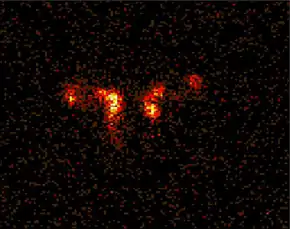Dacryoscintigraphy
Dacryoscintigraphy (DSG), also known as lacrimal scintigraphy, is a nuclear medicine technique for imaging the lacrimal apparatus. It is used to identify obstructions, for example in the lacrimal duct, nasal cavity or nasolacrimal duct.
| Dacryoscintigraphy | |
|---|---|
 | |
| Synonyms | microscintigraphy nuclear dacryocystogram nuclear lacrimal scan lacrimal scintillography |
| ICD-10-PCS | C8191ZZ |
| LOINC | 39670-5 |
Procedure
The typical procedure involves use of Technetium-99m colloid, or in some cases pertechnetate. The colloid is prepared with an activity of approximately 20 megabecquerels in 1 millilitre (ml). Patients place their head in a support and chin rest and a single drop of 0.01 ml is delivered to each eye. Imaging with a gamma camera commences immediately, with a number of images acquired over 15 minutes.[1][2]
Clinical applications
Typical indications include epiphora and dacryocystitis.[3]
DSG allows quantification of tear turnover and drainage.[4] Various quantification models have been developed, which must account for the variable drainage of asymptomatic systems.[5] Some drugs administered to the eye via eye drops, such as beta blockers for glaucoma, can be hazardous if quickly drained and absorbed through the nasolacrimal duct. DSG is considered the best method to quantitatively assess the proportion of the dose drained in this way.[6] It can also be useful in assessing functional problems, where the lacrimal system appears unobstructed, and for post-operative progress.[7][8]
Advantages of DSG over dacrocystography include better functional information and a lack of injection.[9] DSG does not provide precise localisation and may not be useful in cases of complete obstruction.[10]
History
The technique was first introduced in 1972.[11]
References
- "Lacrimal Scintigraphy v2" (PDF). BNMS. June 2018. Retrieved 25 August 2021.
- Costa, Ines M.; Pereira, Luisa R.; Jessop, Maryam; Shawgi, Mohamed; James, Jackie M.; Dizdarevic, Sabina (April 2021). "Lacrimal scintigraphy BNMS Guidelines". Nuclear Medicine Communications. 42 (4): 459–467. doi:10.1097/MNM.0000000000001358. ISSN 0143-3636. PMID 33395194. S2CID 230665389.
- Prakash, Dibya (2014-04-10). Nuclear Medicine: A Guide for Healthcare Professionals and Patients. Springer Science & Business Media. p. 81. ISBN 9788132218265.
- Detorakis, EfstathiosT; Zissimopoulos, Athanassios; Ioannakis, Konstantinos; Kozobolis, VassiliosP (2014). "Lacrimal Outflow Mechanisms and the Role of Scintigraphy: Current Trends". World Journal of Nuclear Medicine. 13 (1): 16–21. doi:10.4103/1450-1147.138569. PMC 4149763. PMID 25191107.
- Tomlinson, Alan; Khanal, Santosh (April 2005). "Assessment of Tear Film Dynamics: Quantification Approach". The Ocular Surface. 3 (2): 81–95. doi:10.1016/S1542-0124(12)70157-X. PMID 17131012.
- Wilson, Clive G (August 1999). "Assessing ocular drug delivery with lachrimal scintigraphy". Pharmaceutical Science & Technology Today. 2 (8): 321–326. doi:10.1016/S1461-5347(99)00176-5. PMID 10441276.
- Chan, WengOnn; Malhotra, Raman; Kakizaki, Hirohiko; Leibovitch, Igal; Selva, Dinesh (September 2012). "Perspective: what does the term functional mean in the context of epiphora?". Clinical & Experimental Ophthalmology. 40 (7): 749–754. doi:10.1111/j.1442-9071.2012.02791.x. PMID 22429759. S2CID 20761303.
- Lefebvre, Daniel R.; Freitag, Suzanne K. (19 November 2012). "Update on Imaging of the Lacrimal Drainage System". Seminars in Ophthalmology. 27 (5–6): 175–186. doi:10.3109/08820538.2012.711413. PMID 23163273. S2CID 27031370.
- Bennett, Paige A.; Oza, Umesh D. (2015-10-13). Diagnostic Imaging: Nuclear Medicine E-Book. Elsevier Health Sciences. p. 304. ISBN 9780323400442.
- Sagili, Suresh; Selva, Dinesh; Malhotra, Raman (10 April 2012). "Lacrimal Scintigraphy: "Interpretation More Art than Science"". Orbit. 31 (2): 77–85. doi:10.3109/01676830.2011.648797. PMID 22489850. S2CID 24169076.
- Rossomondo, R. M.; Carlton, W. H.; Trueblood, J. H.; Thomas, R. P. (1 November 1972). "A New Method of Evaluating Lacrimal Drainage". Archives of Ophthalmology. 88 (5): 523–525. doi:10.1001/archopht.1972.01000030525010. PMID 4634791.